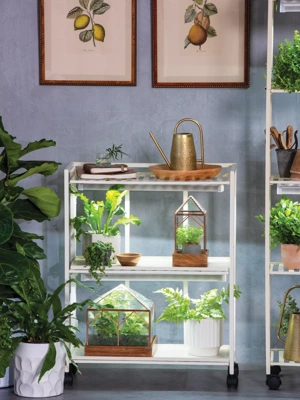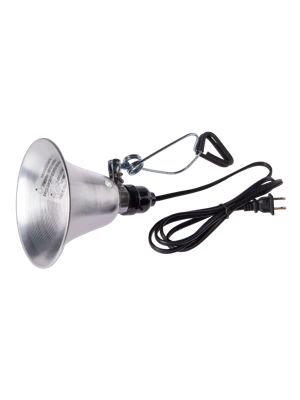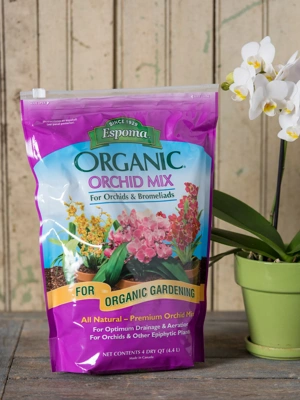Houseplant Care 101
How to grow beautiful plants inside your home
 An assortment of houseplants. Image by Karina Aldredge
An assortment of houseplants. Image by Karina AldredgeMost avid gardeners don't check their love of plants at the front door. We keep ferns in the bathroom, begonias in the study, a dwarf citrus in the living room, pots of rosemary in the kitchen, and seedlings in the basement. Today there are so many interesting plants that can be grown indoors that there's simply no reason for a gardener not to be surrounded by plants all year-round.
Indoor gardening had its first heyday during Victorian times. As plants such as abutilons, palms, and hibiscus were discovered by botanists in remote parts of the world, those who could afford to do so, filled their parlors and conservatories with these exotic beauties. There was another indoor plant revival during the 1970s, though it was largely confined to foliage plants such as spider plants, Swedish ivy, and ferns.
Today, commercial greenhouses offer an eye-popping selection of houseplants to choose from, including orchids, bougainvillea, scented geraniums, exotic begonias, dwarf citrus trees, and giant monstera. Take a moment to do a bit of research! Understanding a plant's native habitat can help you decide which potting soil to use, how often to water, and what room of the house your plant should reside in. The more you know about your indoor plants and their native habitat, the easier it will be to keep them healthy.
3 Basic Guidelines For Growing Gorgeous Houseplants
1. The Right Soil
 Succulents thrive in gravelly, well-drained soil.
Succulents thrive in gravelly, well-drained soil.Your potting mix should be tailored to the particular type of plant you are growing. Cactus, succulents, and rosemary, for example, prefer a coarse, well-drained soil that is about one-third sand. Seedlings should be grown in a light, moisture-retentive, soilless mix. African violets and ferns prefer soil with a high humus content, which can be achieved by adding leaf mold or compost. Many kinds of orchids are happiest growing in nothing but fir bark or sphagnum moss.
Common Potting Mix Components
A typical indoor potting mix is usually composed of peat moss, vermiculite and perlite. These soilless mixes absorb moisture very well and resist compaction, but since they do not contain any nutrients, you must provide your plants with a supply of fertilizer or an occasional dose of compost. One advantage to a soilless mix is that it is sterile, so there is no chance of introducing pest or disease problems.
- Peat Moss: Peat moss is derived from decomposed sphagnum moss and added to potting mixes to help improve drainage and moisture retention.
- Perlite: Mined bits of volcanic rock that aerates and lightens soil, as well as retains moisture. Perlite is an inert, inorganic ("non-living") material, and therefore doesn't rot or decompose.
- Vermiculite: Vermiculite is a naturally-occurring silicate mineral, often added to seed starting mixes to improve moisture retention.
- Bark/Wood Chips: When added to potting mix, bark helps to loosen the mix so it is "chunky" in texture, which improves air flow. It degrades slowly, adding valuable carbon into the growing medium.
- Compost: A nutrient- and microbe-rich amendment that improves the physical, chemical, and biological health of the potting mix.
- Sand: Coarse and gritty, sand improves drainage and aeration.
The most critical consideration when you're purchasing or blending your own potting soil is to ensure that the mix is light enough to provide adequate pore space for air, water and healthy root growth. Month after month of overhead watering, without the benefit of insects, wildlife, and weather to aerate the soil, usually results in an unhealthy, compacted root zone. To ensure that your plants' roots have the oxygen they need for healthy growth, your potting soil should contain plenty of perlite, vermiculite, or sharp sand. This will allow water to drain freely and ensure plenty of air can circulate.
2. The Right Climate
Light
Plants differ greatly in their need for light. Some will be happy with the diffused light from a north window. Others will languish if they don't receive 12 hours of bright light all year-round. Knowing the light requirements for each of your plants will allow you to determine where they will be happiest.
Most flowering houseplants, and some sun-loving foliage plants, need to be within 3 feet of a sunny, south-facing window. Plants that prefer bright, indirect light can be located 3 to 5 feet away from a south-facing window, or within 3 feet of an east- or west-facing window. During the winter months, you may need to move all of your plants closer to the window in order to compensate for the decrease in light.
Most plants perform best when they receive 12 to 16 hours of light per day. If you want to keep your plants blooming during the short days of winter, you may need the boost of a full-spectrum grow light.
Here are a few hints that your houseplants aren't receving enough light:
- Weak, thin, "leggy" stems
- No new growth, or leaves are smaller than normal
- Plants may start dropping their leaves
- Variegated leaves revert to a single pale color, typically pale yellow or white
- The whole plant is leaning towards the window or grow light
- Flowering plants fail to produce buds
Not enought light doesn't spell a total death sentence for your houseplants; simply move them to a sunnier window or under a grow light, and then give them time to acclimate to their brighter surroundings.
Temperature
In their natural habitat, most plants experience a day-to-night temperature fluctuation of at least 10 degrees F. In your home, they will benefit from having a similar temperature differential. Most plants also expect a resting period each year; in fact, some flowering plants actually require a period of dormancy before they will set bud and flower. To simulate this resting period, you should cut back on water and fertilizer during the late fall and early winter, when the intensity and duration of natural light is lowest. Once the day length begins to increase, you can declare it to be spring, and step up the water and fertilizer. Your plants will respond with healthy new growth.
Humidity
 A plant mister can help raise the humidity for ferns and terrarium plants.
A plant mister can help raise the humidity for ferns and terrarium plants.Many plants including succulents, cacti, snake plants, ZZ plants, and Mediterranean herbs (thyme, rosemary) are quite drought-tolerant, and will easily tolerate dry air. However many ferns and tropical plants are happiest when the relative humidity is 50 percent or higher, though they can usually survive at 30 to 40 percent. If the air is much drier than that, they are unable to absorb enough water through their roots to keep up with the water lost through their leaves. Unfortunately, indoor air, especially in the winter, often has a humidity as low as 10 to 20 percent.
Misting your plants helps, however a better solution is to use a cool vapor humidifier (which you will benefit from as well). You can also cluster your plants together so that, as they release moisture into the air, they'll humidify their neighbors. Or try arranging your plants on a gravel-filled tray that contains about 1/4 inch of water. As the water evaporates, it will humidify the air around your plants. Just be careful that the pots don't sit directly in the water.
If all else fails, try positioning your houseplants in the bathroom — daily steam from a hot shower should help keep humidity on track.
3. The Right Care
Watering
More houseplants die from overwatering than from anything else. The best advice is to resist the temptation to water on a regular schedule. Your plants will require frequent watering if the weather has been sunny and warm, and they may not need a drop if the weather has been cool and cloudy. Make a habit of checking the soil of at least a few indicator plants, and water only if it feels dry to a depth of ½ to 1 inch.
When you do water, drench the root ball until you can see some water seep out the bottom of the pot. This will ensure that the entire root ball gets moistened. Small pots will benefit from being soaked in water for about an hour, once a month. Whenever possible, try to water your plants with room temperature water to avoid shocking the roots.
Fertilizing
Indoor plants are usually not too fussy about fertilizers. The most important thing is to not overdo it, and to ensure the plant is thoroughly watered before applying a fertilizer. To avoid the buildup of fertilizer salts, it's a good idea to periodically drench the soil with clean water, then water again with clean water. This will help flush any salts out of the soil.
Select a fertilizer that encourages certain growth such as bloom booster with a high phosphorus ratio such as 5-10-5 for flowering houseplants, or a balanced type such as 5-5-5 for foliage plants. Timing is important: fertilize your houseplant only during active growing months (generally spring through late summer). In the winter, growth slows and many houseplants go dormant and "rest". Fertilizing in winter can sometimes result in weak, spindly growth as a plant will reach for light it cannot acquire.
Pruning
Most healthy houseplants need little to no pruning, although pruning can help control the plant's size, shape, and encourages new growth. When pruning, it's essential to remove dead or yellowing leaves, as well as any stems that appear weak or unhealthy. Additionally, cutting back long, leggy branches promotes bushier growth and maintains a more compact form. Trimming away spent flowers encourages the plant to redirect energy towards producing new blooms. Utilizing clean, sharp scissors or pruning shears is key to prevent unnecessary damage.
Repotting

As plants outgrow their current containers, their roots become cramped and may exhaust the available nutrients. Repotting provides them with fresh soil, ample space for root expansion, and improved drainage. Before initiating the process, carefully remove the plant from its current pot, gently untangle and prune any circling roots, and place it in a slightly larger container (usually just one "size" up from the current pot) with fresh, well-draining soil. Water the plant thoroughly after repotting to help it acclimate to its new environment. This practice not only supports the plant's health but also allows for a quick inspection of roots for any signs of pests or disease.
It should be noted that some houseplants DO prefer to be slightly rootbound (think aloe vera, spider plants, and some types of dracaena). Drought-tolerant plants are often happy with being slightly rootbound, and some flowering houseplants will only bloom when space is tight and energy is focused on flowers, instead of roots. Some plants simply dislike having their roots disturbed.
The Bloomin' Truth
Cultivating a thriving indoor garden is a gratifying journey. By understanding the unique needs of your houseplant and providing them with the right soil, light, and , you can ensure their health and vibrancy. If you do have a struggling houseplant that has been around for a few years, it may simply be aging, and all the TLC in the world may not be able to revive it — plants have a lifespan too. Consider composting, and starting over with a new plant. Remember, houseplants not only enhance the aesthetics of your living space but also contribute to a healthier and more inviting home. Happy gardening!
Last updated: 01/11/2024
Print this Article:
Related items
Get the Dirt
Stay up to date on new articles and advice. Please fill out the information below.

 Full-spectrum grow lights mimic the sun, and let you grow just about anything indoors.
Full-spectrum grow lights mimic the sun, and let you grow just about anything indoors.










